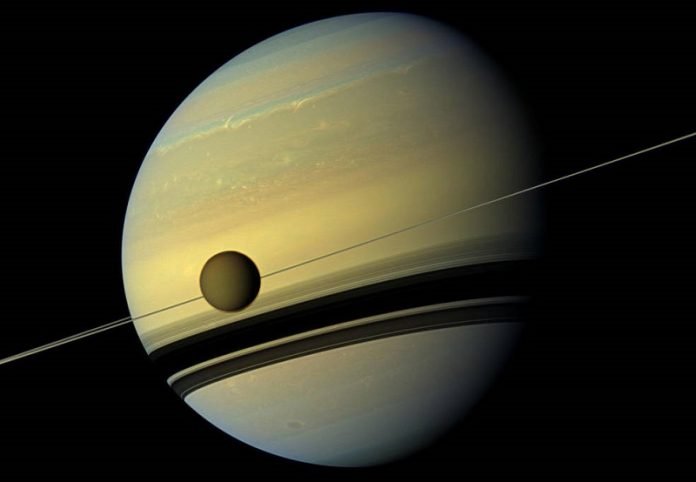
Using data from NASA’s Cassini spacecraft, the international research team found Saturn’s Moon Titan drifting a hundred times faster than previously understood — about 11 centimeters per year.
The revised rate of its drift suggests that the moon started out much closer to Saturn, and that the whole system expanded more quickly than originally believed.
The findings also provide important confirmation of a new theory that explains and predicts how planets affect their moons’ orbits, which could have implications for many other systems.
While scientists know that Saturn formed 4.6 billion years ago in the early days of the solar system, there’s more uncertainty about when the planet’s rings and its system of more than 80 moons formed.
For the last 50 years, scientists have applied the same formulas to estimate how fast a moon drifts from its planet, a rate that can also be used to determine a moon’s age.
The theories assumed that in systems such as Saturn’s, with dozens of moons, the outer moons like Titan migrated outward more slowly than moons closer in because they are farther from their host planet’s gravity.
Four years ago, theoretical astrophysicist Jim Fuller published research that challenged this model.
Fuller’s theory, known as the resonant locking model, predicted that outer moons can migrate outward at a similar rate to inner moons because they become locked in a different kind of orbit pattern that links to the particular wobble of a planet and slings them outward.
The new results have confirmed that this model is a much better fit for the real data recorded by the Cassini spacecraft.
Cassini data continues to reveal Saturn’s secrets
The new findings were made by observing independent data sets captured by different instruments aboard the Cassini spacecraft.
Images collected by the spacecraft’s Imaging Science Subsystem (ISS) mapped stars in the background of Cassini images and tracked Titan’s position.
These results were then confirmed using new data taken from Cassini’s radio science experiment recorded during ten close flybys between 2006 and 2016, along with historical observations of the positions of Saturn’s moons going back to 1886.
Professor Carl Murray, Professor of Mathematics and Astronomy at Queen Mary, was the only UK member of the Cassini ISS Team and his research group at Queen Mary was responsible for designing around 12 percent of the more than 400,000 images taken by the Cassini spacecraft, which are continuing to uncover Saturn’s secrets in studies like this.
Professor Murray, said: “It’s great to see that all those years of hard work designing images to be taken by the Cassini spacecraft and analysing the returned data are still paying dividends as we continue to learn more about the secrets of the Saturn system.
Cassini is a mission that is still surprising us and, no doubt, it will continue to do so for many years to come.”
Dr Nick Cooper, a research fellow at Queen Mary who has worked on the analysis of Cassini data since 2002, said: “It’s amazing to think that just by painstakingly measuring the positions of Saturn’s moons and background stars in our Cassini images for more than a decade, we can learn something about the unseen processes that occur in the interior of the planet Saturn.
We are convinced that there are many more discoveries to follow as Saturn gives up its secrets.”
Managed by NASA’s Jet Propulsion Laboratory in Southern California, Cassini was an orbiter that observed Saturn for more than 13 years before plunging into the planet’s atmosphere in September 2017 once it had exhausted its fuel supply.



